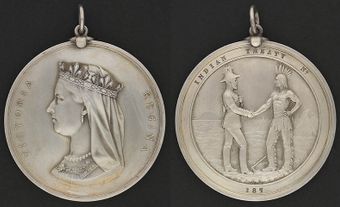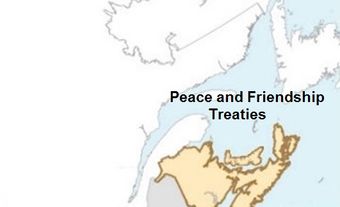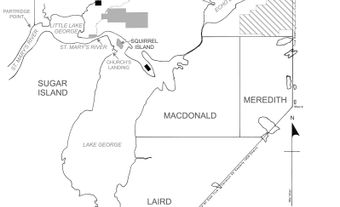Treaty 9 (also known as the James Bay Treaty) is one of the 11 post-Confederation Numbered Treaties negotiated with Indigenous peoples in Canada between 1871 and 1921. (See also Treaties with Indigenous Peoples in Canada.) Signed in 1905-6, Treaty 9 covers most of present-day Ontario north of the height of land dividing the Great Lakes watershed from the Hudson and James Bay drainage basins. The purpose of Treaty 9 was to purchase the interests of the resident Cree and Ojibwe peoples to lands and resources to make way for white settlement and resource development. Treaty 9, like other Numbered Treaties, contained provisions for cash treaty payments, the creation of reserves, education and hunting, fishing and trapping rights.
(courtesy Native Land Digital / Native-Land.ca)
Historical Background
The land cession treaty system began in Upper Canada (modern Ontario), where many treaties were negotiated with the Indigenous population between 1764 and 1862. These pre-Confederation treaties contained provisions, such as hunting and fishing rights, for the Indigenous signatories.
After 1870, the government of Prime Minister John A. Macdonald began applying the land cession treaty system to the newly acquired western territories of the Hudson’s Bay Company. Treaty 1 (1871) to Treaty 7 (1877) opened the lands of the Prairie fertile belt to White settlement. The western land cession treaties were a cornerstone of Macdonald’s National Policy based on European immigration, transcontinental railway development and tariff protection for manufacturers. (See also Numbered Treaties.)
Reasons for Treaty 9
In the 1880s, Cree and Ojibwe peoples in the James Bay region were increasingly concerned about presence of non-Indigenous trappers and prospectors on their traditional lands. The Cree and Ojibwe protested verbally and in petitions to Hudson’s Bay Company traders and to federal and provincial government officials. They were concerned, in particular, with the decline of the local beaver population. They wanted protection for their lands, resources and fur-bearing animals. Many Indigenous leaders and their peoples were aware of treaty activity in neighbouring territories, such as the Robinson-Huron and Robinson-Superior treaties (1850) and the Northwest Angle Treaty, also known as Treaty 3 (1873). A petition from Indigenous leaders for a similar treaty in the summer of 1901 started the treaty-making process.
Drafting the Treaty Terms
Due to a precedent set after the signing of Treaty 3, Dominion and provincial officials were involved in the drafting of the terms for Treaty 9. When Treaty 3 was signed in 1873, there was a dispute over the selection, size and location of the reserves. The landmark St. Catherine’s Milling and Lumber case (1887) led to an agreement between Ontario and the Dominion in 1894 that specified, among other matters, “that any future treaties with the Indians in respect of territory in Ontario…shall be deemed to require the concurrence of the Government of Ontario.”
The terms of Treaty 9 were finalized in advance by the Dominion and Ontario governments and then presented to Indigenous leaders as a done deal. Treaty 9 followed the format of the earlier Numbered Treaties; in fact, the provision on hunting and fishing rights was copied verbatim from Treaty 8 (1899). The Province of Ontario, for its part, made four demands. First, one of the three treaty commissioners was to be a provincial appointee. Second, instead of allowing the Indigenous peoples to select their own reserves, those sites were to be determined by the three commissioners. Third, annuity payments and related treaty costs were the responsibility of the Dominion. Finally, no site suitable for the development of water power exceeding 500 horsepower was to be included within the boundaries of any reserve.
Any negotiating power the Indigenous peoples might have had was removed by Ontario’s power of veto over the terms of the treaty. In 1906, Duncan Campbell Scott, the Dominion treaty commissioner, spoke to this issue in an article in Scribner’s Magazine (an American periodical). In it, he said that the Indigenous peoples were to undertake certain promises and “we were to make certain promises, but our purpose and our reasons were alike unknowable.” He continued:
What could they [Indigenous peoples] grasp of the pronouncement on the Indian tenure [usufructuary] which had been delivered by the law lords of the Crown, what of the elaborate negotiations between a dominion and a province which had made a treaty possible, what of the sense of traditional policy which brooded over the whole? Nothing. So there was no basis for argument. The simple facts had to be stated and the parental idea developed that the King is the great father of the Indians, watchful over their interests, and ever compassionate.
The Dominion and Ontario governments appointed three commissioners to “negotiate” Treaty 9. The Dominion was represented by Duncan Campbell Scott and Samuel Stewart of the Indian Affairs Department. The provincial representative was Daniel G. MacMartin, a mining specialist from Perth, Ontario.
Written Terms

The terms of Treaty 9, as approved by an order-in-council on 3 July 1905, had a format similar to Treaties 1–8. The preamble to the treaty stated its purpose. It was to open the Northern Ontario lands “for settlement, immigration, trade, travel, mining, lumbering and other such purposes.” The Indigenous signatories were required to “cede, release, surrender and yield up…their rights, titles and privileges” to lands and resources within the limits of the treaty — some 233,100 km2— along with another 103,600 km2in the Northwest Territories, and “all other lands wherever situated in Ontario, Quebec, Manitoba, the District of Keewatin or in any other portion of the Dominion of Canada.” Upon signing, the Indigenous peoples received a one-time lump sum payment of $8; in addition, each chief received a Union Jack flag and a copy of the treaty. Treaty annuities were set at $4 for each person.
In regard to education, the treaty promised “as may seem advisable,” to provide for the salaries of teachers, the cost of school buildings and educational equipment. (See also Education of Indigenous Peoples in Canada.) Reserve lands were set aside proportionally based on a formula of one square mile (2.6 km2) per family of five. (See also Reserves in Ontario.) In turn, the Indigenous peoples promised not to sell reserve land; however, they would receive compensation if reserve lands were needed for “public works, buildings, railways or roads.”
Finally, traditional pursuits such as hunting, fishing and trapping could continue as before, subject to federal “regulations,” except on tracts of land required for settlement, mining, lumbering, trading or other purposes.
Treaty Proceedings
Between 1905 and 1906, treaty commissioners traveled to Cree and Ojibwe communities in Northern Ontario to explain the written terms of Treaty 9 to local populations. They also administered and witnessed the signing of the treaty, helped to select reserve lands and distributed various goods and cash payments to the Indigenous peoples on behalf of the Dominion government.
1905 Trip, 30 June–9 September
The commissioners left Ottawa on 30 June 1905 by train and arrived at Dinorwic in northwestern Ontario on 2 July. A physician, A.G. Meindl, and two Dominion Police constables were included in the party. They were met by Hudson’s Bay Company Chief Trader T.C. Rae. With the help of Rae and his crew of Albany River guides, the treaty party set off for Osnaburgh House (in present-day Kenora district). They took with them personal luggage, money, medical supplies to treat the Indigenous peoples, and other items.
The treaty commissioners visited several northern Cree and Ojibwe communities in the summer of 1905. The commissioners provided an official government account of their travels and community deliberations. Since the treaty had already been prepared, the trip was relatively uneventful and treaty-related discussions developed a familiar pattern. When the commissioners arrived to “make treaty,” usually at Hudson’s Bay Company posts, the assembled Indigenous communities selected leaders to meet with the commissioners. The treaty was explained in Ojibwe and Cree languages by either Hudson’s Bay Company officials or missionaries. The Indigenous people then withdrew to discuss matters. There were no negotiations. Upon signing, cash payments were made, and flags and a copy of the treaty were handed out. The sites for future reserves were then selected, a process carefully monitored by the Ontario commissioner. A feast celebrated the closure of treaty proceedings.
The treaty commissioners returned to Ottawa in early September 1905. Scott and his fellow commissioners filed a formal report to the Superintendent General of Indian Affairs on 6 November 1905. Attached to his report was a schedule of reserves for Indigenous people at Osnaburgh, Fort Hope, Marten Falls, English River, Fort Albany, Moose Factory and New Post. The vast size of Treaty 9 territory and scattered Indigenous communities made a second treaty trip necessary in the summer of 1906.

1906 Trip, 22 May–14 August
The second treaty trip was something of a lark. T.C Rae had been replaced by Pelham Edgar (1871–1948), a professor of English at Victoria College, University of Toronto. A good friend of Duncan Campbell Scott, Edgar also acted as secretary for the commissioners.
Treaty-related proceedings followed the scenario set in 1905. There was an initial complication at the Fort Abitibi post, which was located inside the boundary of the province of Quebec. Local Indigenous leaders in Quebec wanted to adhere to the treaty. The commissioners explained they had no authority to deal with them, but that they would try to obtain reserve lands for them from the Quebec government. Treaty discussion and signings at the remaining six stops on the trip were uneventful. On 5 October 1906, Scott and his fellow commissioners sent their report to the Superintendent General, along with a schedule of reserves for Indigenous peoples at Abitibi, Matachewan, Mattagami, Flying Post, Chapleau (Ojibwe), Chapleau (Cree), New Brunswick House and Long Lake. For the time being, treaty making had been completed.
Adhesions
In the decades following the treaty trips of 1905–06, other Indigenous groups (likely Cree, Algonquin or Ojibwe-speaking people) in Northern Ontario wished to be represented in Treaty 9. The Dominion and provincial governments made adhesions to include them.
Resuming Treaty Talks
About a quarter century elapsed until treaty activity resumed in 1929. Most of the momentum for adhesions to Treaty 9 came from the Indigenous peoples living north of the 1905 and 1906 treaty boundary line. For example, in July 1915, James Stoney, representing peoples far up the Hudson Bay coast at Winisk and Fort Severn wrote:
We would like to join in a treaty as the other Indians at York Factory on the west of us or Albany, Fort Hope, Osnaburgh, Attawapiskat on the south of us. We have never been asked to get into any of these Treaties. We are practically surrounded by these Indians who get help from the Government and our hunting grounds in this cold climate are very poor and we would be very pleased to be able to join in any of these Treaties. Now that the Hudson’s Bay Company is being approached by railways and white men are coming into this northern country we will be driven from our land.
After 1915, Indian Affairs received petitions from the Indigenous peoples citing high food prices, poor fur hunts and limiting game regulations. Thirteen years later, Indian Affairs officials had identified the Indigenous groups living in the area that was to be surrendered. In May 1929, Duncan Campbell Scott, now deputy superintendent-general of Indian Affairs (1913–32), noted, “the Indians residing in the District of Patricia are much exercised over the rapid disappearance of the fur-bearing animals” which they attributed “to the inroads of white trappers.” Scott hoped the Province of Ontario would see “the justice of setting apart various tracts in which the Indians shall have the sole right to take game, or that the game laws may be so modified as will preserve to the Indians a continuance of living.”
Adhesion Trips of 1929 and 1930
The Dominion and Ontario governments appointed two treaty commissioners to preside over adhesion proceedings: Herbert Nathaniel Awrey from the Indian Affairs Department represented the Dominion government and Walter Cain, deputy minister of lands and forests, represented Ontario. For the first time, aircraft were used to transport the treaty commissioners to specific destinations. Trout Lake was the first stop. The terms of Treaty 9 (the same as in 1905) were explained to the gathering. The treaty was signed, witnessed, and cash payments and other items were distributed. The sites for reserves were identified. As in 1905, there were no negotiations.
On 17 July 1930, Cain and Awrey flew on to the Windigo River at Nikip, Quebec. According to them, they thoroughly explained the treaty to the Indigenous leaders there, at which point the leaders asked them questions which were “fully answered.” After that, the Indigenous peoples “indicated readiness to sign the Adhesion.”
In 1930, the final two groups from Fort Severn and Winisk were admitted to treaty. In total, the Treaty 9 adhesions took in about 331,500 km2. Treaty 9 and its adhesions covered more than two-thirds of what is now the province of Ontario. After cash payments had already been paid to about 3,000 Indigenous peoples in 1905–06, the adhesions added approximately 2,000 more to that total.
Interpretations and Impacts
Treaty 9 created more legal controversies and socio-economic problems than the treaty commissioners could ever have imagined. (See also Social Conditions of Indigenous Peoples in Canada and Economic Conditions of Indigenous Peoples in Canada.) Was it viewed as an instrument for Indigenous peoples and non-Indigenous peoples to share the land and the natural resources? Did the Cree and Ojibwe leaders understand the meaning and implication of such treaty terms as “cede, release, yield up and surrender”? These legal concepts were not part of the Cree and Ojibwe vocabulary or world view.
The provisions of Treaty 9 have had long-lasting impacts on the Indigenous peoples in that area. Treaty 9 opened the riches of the James Bay Lowlands to resource development. Resource Impact Benefit Agreements have been negotiated with local Indigenous communities. However, the social and economic misery of many Northern Ontario Indigenous communities, most notably Attawapiskat First Nation and Kashechewan First Nation, testify to a defective treaty system and failed policy.
Reconciliation and Renewal
The provincial and federal governments have negotiated settlements with various Treaty 9 First Nations that aim to correct historic wrongs. In July 2020, the Government of Ontario and Flying Post First Nation announced a $14.1 million settlement in a land claim dating back to 1905.
In October 2020, representatives of the federal government and Missanabie Cree First Nation announced a $150 million settlement to resolve a longstanding issue related to Treaty 9 land. Missanabie Cree Nation was promised a reserve in 1906 but did not receive land until 2018. The 2020 settlement provides Missanabie Cree First Nation with the ability to add 12.95 km2 to their reserve.

 Share on Facebook
Share on Facebook Share on X
Share on X Share by Email
Share by Email Share on Google Classroom
Share on Google Classroom






